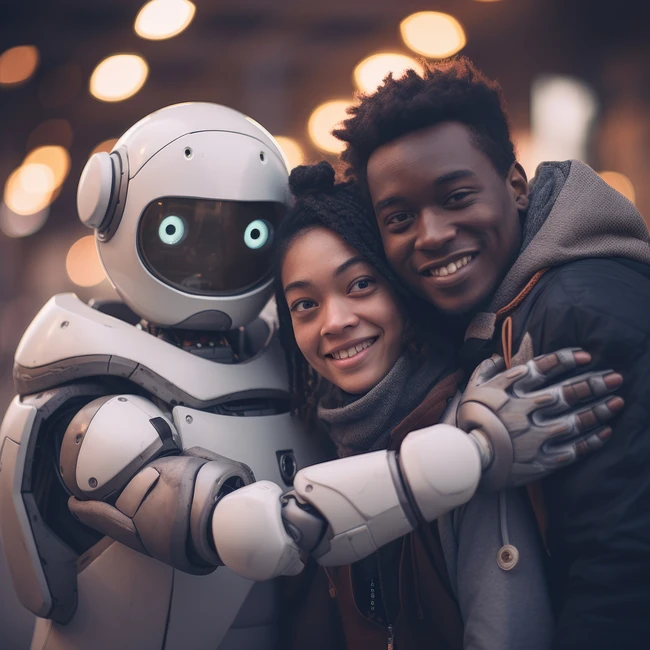
One of the interesting parts of AI-generated art is its potential to catalyze collaboration between humans and machines. Humans can input concepts into AI systems, which then generate various results that the human artist can select from further refining. Are machines truly capable of creativity?, this is a significant question that emerges as we witness the rise of AI.
Acknowledging the distinctive elements of human creativity is crucial to fathom this. A pivotal role in the creative process is our ability to draw from emotions, personal experiences, and intuition. The uncertainty and depth that characterize human-made art, music, and literature contribute to these qualities.
AI, on the other hand, can create content, analyze patterns, and copy specific creative styles. It operates on algorithms and data analysis, but the question remains, does it genuinely comprehend and experience creativity? While AI has produced impressive works of art, music, and literature, depth and genuine emotional connection found in human-made expressions are the critics argue that these creations lack.
At a pace unmatched by any other application ChatGPT surged past the 100 million user mark. As of February 2023, an average of 25 million visitors was hosted daily by chat.openai.com. Projections from eMarketer anticipate that more than 20% of the American population will use ChatGPT monthly by 2024.
AI is merely replicating patterns it has learned or if it can genuinely innovate and bring forth something entirely new is the debate hinged on. Potential lead to novel combinations and ideas is the proponents of AI’s creativity point to its ability to amalgamate vast amounts of information quickly.
Read: Perplexity AI vs ChatGPT
owever, a deep understanding of the human condition within AI systems arises from the absence of true emotional experiences.
Can AI Learn To Be Creative
According to experts, we’ve barely scratched the surface of what is possible. While advancements in AI mean that computers can be taught certain aspects of creativity, professionals doubt the extent to which AI can develop its sense of creativity. Is it possible to teach AI to create without guidance? Can it truly comprehend what is beautiful, perhaps by looking at pixel arrangements or color patterns?
“Only a few years ago, who would have imagined we’d be able to instruct a computer what is or is not creative ?”. I believe teaching AI what’s melodic or beautiful is an issue of a different kind since it is more subjective, but likely can be attained. AI can be given a bunch of training data that indicates, ‘I think this is beautiful. This does not seem beautiful.’ And even though people might have different ideas about what beauty is, I think the computer will be able to find a good range. Now, if you ask it to create something beautiful from scratch, I think that’s certainly a more distant and challenging frontier.
Benefits of AI in Creative Automation
Using AI techniques in creative automation can have several benefits. However, brands must keep in mind that such software solutions are only supportive and cannot take the role of humans entirely. Humans, on the other hand, must acquire how to effectively use AI-enabled creative automation solutions. Here are a few of the benefits of utilizing AI-powered creatives.
- Improved efficiency and TAT: Creative scaling is a critical challenge as creative teams must frequently produce more content that’s fresh, unique, and personal. AI-powered creative automation solutions assist in this area. While content creation, design, and editing are still tasks performed by humans, AI can help minimize the repetitive steps. This allows marketers and designers to concentrate on more strategic aspects of the content and reduce turnaround times.
- Deeper personalization: Using machine learning to sift through customer data, brands can make better decisions regarding marketing collaterals. Brands can utilize AI to create more personalized content based on user data. This results in increased engagement rates and increased customer satisfaction.
- Enhanced creativity: Creative blocks are common with marketing and creative teams. Teams can often find it difficult to create fresh concepts that align with diverse marketing requirements. With the assistance of AI, teams can now generate creative ideas, designs, and content that may not have been thought of otherwise. This can inspire new approaches and ideas, that result in more innovative and effective campaigns.
- Cohesive and consistent brand experience: While AI does not directly assist with consistent content creation, it can help perform certain repetitive objectives that are necessary to make sure that the marketing collaterals comply with the brand guidelines. Using the brand guidelines, AI can automate the process of generating marketing materials such as social media posts and advertisements, making sure that all elements comply with the established guidelines. For instance, an AI system can automatically resize and reformat images to fit certain platforms, while also making sure that the color scheme and typography remain consistent.
- Optimization of content: AI can analyze data and help make decisions regarding content and design. For example, it can offer layout, color, and font choices, resulting in more effective designs that capture user attention and increase engagement rates. They can also help in optimizing content elements such as headlines, descriptions, and calls to action.
- Saves time and cost: By eliminating the need to attend to repetitive and mechanical tasks, AI-enabled creative solutions can assist expedite the ideation and creation process, reducing effort for creators. For example, AI can help with template-based designs, recommend intelligent assets, automate repetitive tasks, and facilitate iterative developments. Because of this time-saving advantage, content producers may focus more of their energy on more strategic and creative aspects of their work, and produce a higher amount of high-quality content.
- Predictive analytics: Predictive analytics has always been a strong suite of machine learning solutions. Businesses have been utilizing machine learning for years to understand business trends, customer behavior, and more. Now, brands can leverage Creative Automation Software with AI to make informed decisions about content strategy and design, leading to more effective campaigns and better user experiences.
Limitations of AI in Creative Automation
While AI-enabled techniques can greatly streamline work, there are various limitations that brands must be aware of. The following are some of the key problems with employing AI tools for creative purposes.
- Shift in creative roles: AI-enabled tools will not replace workers but rather help them. Instead of AI replacing people, it will be those who use AI replacing those who don’t. Creative teams will need to get used to utilizing AI-enabled creative automation techniques to do their job more effectively. Often, such tools frequently call for expertise that is outside the specialization of the team members. In the case of creative automation, team members must learn to understand how to efficiently provide human input and oversight in the AI-enabled creative process. Members of the team who are not trained to effectively use such tools will be the primary limitation of AI-assisted creative automation solutions.
- Lack of creative judgment: While AI is capable of producing ideas and designs, it cannot make creative judgment calls. For example, AI can assist you in writing the code, but it cannot create the product. AI can assist you with making the designs, but it is not capable of producing truly innovative or groundbreaking marketing campaigns. This requires a deeper insight into human behavior.
- Dependence on data quality: Most machine-learning models need a large amount of data to be trained and deployed. These systems use a lot of data to create designs, optimize content, and identify areas of improvement. This implies that the quality of the data used to train these systems is crucial to their effectiveness and accuracy. This data might not always be representative or accurate, which could result in designs that are not effective for a broader audience. Moreover, with inconsistent or erroneous data, you can receive inaccurate recommendations or ineffective designs.
- The issue of bias and fairness: Biases in the data used to train AI can be perpetuated. For example, if an AI system is educated on data that is biased toward a specific group of individuals, it may develop discriminating or unjust designs. Brands must be watchful about such cases.
- Inability to understand the context: While AI is capable of producing technically correct designs and content based on its training data, it might not be able to interpret and react to the broader context of the campaign or project it is being used for. This can result in designs or content that are inappropriate or ineffective for the target audience or message. To remove this restriction, it is significant to offer context and direction to the AI system, so that the system can be taught on certain data sets and human intervention can be used only to augment or overrule its choices as needed.
Conclusion
While AI's ability to emulate creativity is incredibly good, genuine creativity – stemming from emotions, experiences, and intent – remains inherently human. Instead of viewing AI as a replacement, we should see it as a powerful tool, one that can augment our creative processes, pushing us into realms we've yet to imagine









